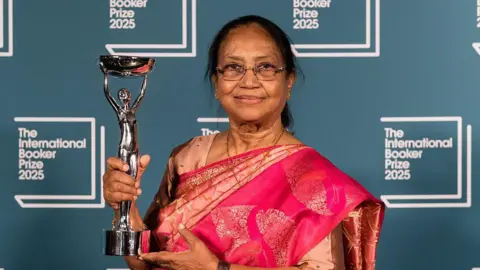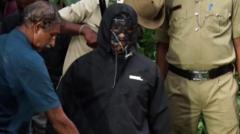Guru Dutt, a masterful filmmaker known for his superb storytelling and emotional depth, passed away at only 39 years of age in 1964, yet the impact of his work reverberates to this day. Born on July 9, 1925, in Karnataka, this month marks his 100th birthday, an occasion that prompts us to reflect on both his cinematic genius and the hidden struggles that colored his life.
The creator of powerful classics like *Pyaasa* and *Kaagaz Ke Phool*, Dutt's filmmaking was deeply personal and introspective, a reflection of the tumultuous period of India's post-independence era. His films often mirrored his own experiences and dealt with tough realities, blending stunning visuals with profound narratives.
Dutt's early life was steeped in hardships, marked by financial strain and family difficulties. Relocating to Bengal, he flourished amidst rich cultural influences, ultimately shaping his artistic vision. He entered the film industry in the 1940s, beginning as a choreographer, while also juggling various jobs, including that of a telephone operator.
Dutt's big break arrived via his friendship with actor Dev Anand, leading to his directorial debut with the 1951 noir thriller, *Baazi*. This success set the stage for a torrid love affair with Geeta Roy and a booming career punctuated by hit films like *Aar-Paar* and *Mr & Mrs 55*.
However, his most defining work, *Pyaasa*, emerged from a period of intense personal turmoil. This film, deeply resonating with themes of disillusionment in an increasingly materialistic society, is now celebrated as one of the greatest films of all time. Yet, the enormous pressure of perfecting his vision led Dutt down a path of increasing dependency on alcohol and sleeping pills, impacting his mental health.
In an alarming twist, Dutt's emotional battles became starkly visible when he attempted suicide in 1956, just as *Pyaasa* neared completion. Though he recovered, his struggles were not adequately addressed, as mental health remained a taboo topic in society. Upon the film's release in 1957, critical acclaim did not fill the void he felt; he expressed a haunting emptiness despite achieving all he had sought.
Dutt's films often portrayed strong women, yet paradoxically, his own relationships were fraught with conflict over gender roles, particularly with his wife. Following *Pyaasa*, he veered into making the semi-autobiographical *Kaagaz Ke Phool*, which mirrored his personal life and experiences of loneliness. Despite its later recognition, it was a commercial failure that weighed heavily on him.
With a complex mix of artistic daring and personal demons, Dutt's late career continued to be paradoxical. He delivered successful films like *Sahib Bibi Aur Ghulam* while battling severe mood swings and loneliness. His reliance on substances for comfort deepened, culminating in a second suicide attempt that left him unconscious for three days.
Ultimately, Dutt's life ended tragically on October 10, 1964, when he was found dead in his room, leaving behind a legacy that remains steeped in both brilliance and sorrow. His co-star Waheeda Rehman poignantly remarked on his longing for death, a stark contrast to the vitality reflected in his work.
As we remember Guru Dutt on the centennial of his birth, we are reminded that true recognition for his vision came only posthumously. His untold struggles, as well as his cinematic contributions, now encourage a broader discussion about mental health and artistic integrity in the realm of cinema.
Yasser Usman is the author of the biography *Guru Dutt: An Unfinished Story*.
The creator of powerful classics like *Pyaasa* and *Kaagaz Ke Phool*, Dutt's filmmaking was deeply personal and introspective, a reflection of the tumultuous period of India's post-independence era. His films often mirrored his own experiences and dealt with tough realities, blending stunning visuals with profound narratives.
Dutt's early life was steeped in hardships, marked by financial strain and family difficulties. Relocating to Bengal, he flourished amidst rich cultural influences, ultimately shaping his artistic vision. He entered the film industry in the 1940s, beginning as a choreographer, while also juggling various jobs, including that of a telephone operator.
Dutt's big break arrived via his friendship with actor Dev Anand, leading to his directorial debut with the 1951 noir thriller, *Baazi*. This success set the stage for a torrid love affair with Geeta Roy and a booming career punctuated by hit films like *Aar-Paar* and *Mr & Mrs 55*.
However, his most defining work, *Pyaasa*, emerged from a period of intense personal turmoil. This film, deeply resonating with themes of disillusionment in an increasingly materialistic society, is now celebrated as one of the greatest films of all time. Yet, the enormous pressure of perfecting his vision led Dutt down a path of increasing dependency on alcohol and sleeping pills, impacting his mental health.
In an alarming twist, Dutt's emotional battles became starkly visible when he attempted suicide in 1956, just as *Pyaasa* neared completion. Though he recovered, his struggles were not adequately addressed, as mental health remained a taboo topic in society. Upon the film's release in 1957, critical acclaim did not fill the void he felt; he expressed a haunting emptiness despite achieving all he had sought.
Dutt's films often portrayed strong women, yet paradoxically, his own relationships were fraught with conflict over gender roles, particularly with his wife. Following *Pyaasa*, he veered into making the semi-autobiographical *Kaagaz Ke Phool*, which mirrored his personal life and experiences of loneliness. Despite its later recognition, it was a commercial failure that weighed heavily on him.
With a complex mix of artistic daring and personal demons, Dutt's late career continued to be paradoxical. He delivered successful films like *Sahib Bibi Aur Ghulam* while battling severe mood swings and loneliness. His reliance on substances for comfort deepened, culminating in a second suicide attempt that left him unconscious for three days.
Ultimately, Dutt's life ended tragically on October 10, 1964, when he was found dead in his room, leaving behind a legacy that remains steeped in both brilliance and sorrow. His co-star Waheeda Rehman poignantly remarked on his longing for death, a stark contrast to the vitality reflected in his work.
As we remember Guru Dutt on the centennial of his birth, we are reminded that true recognition for his vision came only posthumously. His untold struggles, as well as his cinematic contributions, now encourage a broader discussion about mental health and artistic integrity in the realm of cinema.
Yasser Usman is the author of the biography *Guru Dutt: An Unfinished Story*.


















